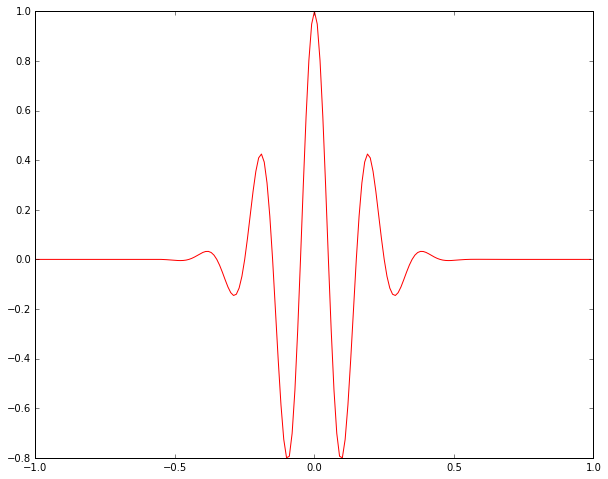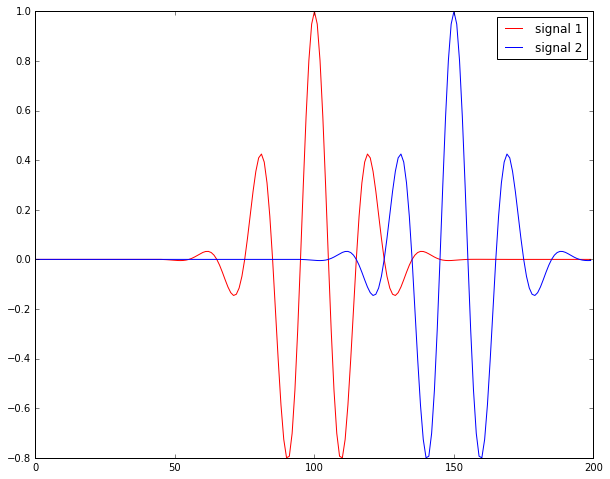Cross-corrlation is a technique widely used in many fields. I won't go to the details of it, since wikipedia already gave a very nice introduction. In seismology, cross correlation is a great tool, for example, to find the amount of shift of one signal recorded different locations on earth, you can use cross correlation; using ambient noise cross correlation, we can find the empirical green's function between two seismic stations; to monitor the nuclear tests around the world, cross correlation also be used to do the pattern recognition on the waveforms recorded. Of course, there are still many other use cases in seismology, therefore, today we will talk about how to do cross correlation in frequency domain. You can find all the scripts at Qingkai's Github.
You can also do the cross correlation in time domain. But doing this in frequency domain is very simple, and clear, and of course faster as well (I tested both version in the frequency/time domain).
import numpy as np
from obspy.core import read
import matplotlib.pyplot as plt
from numpy.fft import fft, ifft, fftshift
%matplotlib inlineLet's create the first signal
For simplicity, we will create the first signal using scipy. We will create a gaussian pulse.
from scipy import signal
t1 = np.linspace(-1, 1, 2 * 100, endpoint=False)
sig1 = signal.gausspulse(t1, fc=5)
plt.figure(figsize=(10,8))
plt.plot(t1, sig1, 'r')
plt.show()Create the 2nd signal by simply shift it
For simplicity, we will just shift the first signal by 50 data points, and use it as the second signal. We will use the function we created in the previous post - shift signal in frequency domain to shift the signal in the frequency domain.
def nextpow2(i):
'''
Find the next power 2 number for FFT
'''
n = 1
while n < i: n *= 2
return n
def shift_signal_in_frequency_domain(datin, shift):
'''
This is function to shift a signal in frequency domain.
The idea is in the frequency domain,
we just multiply the signal with the phase shift.
'''
Nin = len(datin)
# get the next power 2 number for fft
N = nextpow2(Nin +np.max(np.abs(shift)))
# do the fft
fdatin = np.fft.fft(datin, N)
# get the phase shift, shift here is D in the above explanation
ik = np.array([2j*np.pi*k for k in xrange(0, N)]) / N
fshift = np.exp(-ik*shift)
# multiple the signal with shift and transform it back to time domain
datout = np.real(np.fft.ifft(fshift * fdatin))
# only get the data have the same length as the input signal
datout = datout[0:Nin]
return datout# This is the amount we will move
nShift = 50
# generate the 2nd signal
sig2 = shift_signal_in_frequency_domain(sig1, nShift)
# plot two signals together
plt.figure(figsize=(10,8))
plt.plot(sig1, 'r', label = 'signal 1')
plt.plot(sig2, 'b', label = 'signal 2')
plt.legend()
plt.show()Frequency domain cross correlation
Shift a signal in the frequency domain is quite simple.
- zero-pad the input signals or apply a taper as we talked last week. (I didn't do this, since I know my two signal is zero at both ends, so I skip it)
- take the FFT of both signals
- multiply the first signal, and the reverse of the signal (or the conjugate, note that in the frequency domain, the complex conjugation is equivalent to time reversal in the time domain)
- do the inverse FFT and get the shift
reference:
stackexchange
stackexchange
def cross_correlation_using_fft(x, y):
f1 = fft(x)
# flip the signal of y
f2 = fft(np.flipud(y))
cc = np.real(ifft(f1 * f2))
return fftshift(cc)
# shift < 0 means that y starts 'shift' time steps before x
# shift > 0 means that y starts 'shift' time steps after x
def compute_shift(x, y):
# we make sure the length of the two signals are the same
assert len(x) == len(y)
c = cross_correlation_using_fft(x, y)
assert len(c) == len(x)
zero_index = int(len(x) / 2) - 1
shift = zero_index - np.argmax(c)
return shift
calculate_shift = compute_shift(sig1, sig2)
print('The shift we get from cross correlation is %d, the true shift should be 50'%calculate_shift)
You can see the result will be 50, which is our correct shift.


Hello,
ReplyDeleteThank you for the helpful post.
Replacing line
f2 = fft(np.flipud(y))
in cross_correlation_using_fft() with
f2 = np.conjug(fft(y))
leads to an off-by-one error for compute_shift(). How could that be explained?
Five weeks ago my boyfriend broke up with me. It all started when i went to summer camp i was trying to contact him but it was not going through. So when I came back from camp I saw him with a young lady kissing in his bed room, I was frustrated and it gave me a sleepless night. I thought he will come back to apologies but he didn't come for almost three week i was really hurt but i thank Dr.Azuka for all he did i met Dr.Azuka during my search at the internet i decided to contact him on his email dr.azukasolutionhome@gmail.com he brought my boyfriend back to me just within 48 hours i am really happy. What’s app contact : +44 7520 636249
ReplyDelete